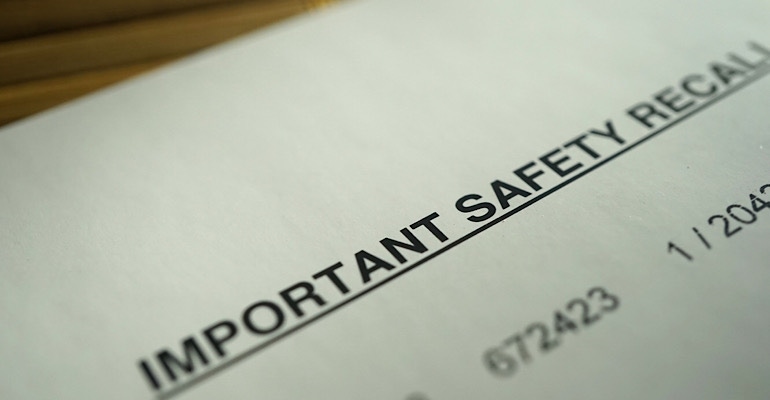Report Links Regulatory Submission Characteristics & Device Recalls
A study from the University of Minnesota offers guidance on how to avoid safety recalls for 510(k) devices.

New research from the University of Minnesota, published in the Journal of the American Medical Association, challenges conventional wisdom and prompts discussion among medical device manufacturers by raising questions about—and perhaps providing guidance to help avoid—FDA safety recalls for 510(k) devices.
The study, titled “Association Between Regulatory Submission Characteristics and Recalls of Medical Devices Receiving 510(k) Clearance,” sought to answer the question: “Are features of predicate medical devices referenced in 510(k) regulatory submissions associated with product recalls?”
The outcomes may be surprising because they suggest that newer is not necessarily better. They also identify other factors that could determine whether a device ends up in the 11.4% of devices that experience at least one class I or class II recall (i.e., recalls with a potential for harm).
Background
As manufacturers are aware, FDA has three broad classifications for medical devices. Depending on the classification, FDA provides different paths for the devices to establish their safety and efficacy so they can be legally marketed. Most devices are class II devices. FDA requires class II devices to submit a 510(k) application to demonstrate the device’s substantial equivalence in both safety and efficacy to a legally marketed, or “predicate” device already cleared through the 510(k) process.
The Minnesota study explored the potential for class II devices to be recalled by analyzing the predicate devices cited in their 510(k) submissions. In other words, the authors examined the relationship between the devices seeking clearance, or “applicant devices,” and the predicate devices cited within the applicant devices’ 510(k) submissions.
Factors Analyzed to Determine the Probability of A Recall
The authors downloaded summary documents from FDA website as their evidence and created an algorithm to extract text to identify applicant devices and their cited predicate devices. The authors identified the following key areas from the applicant devices’ 510(k) submissions:
Total number of cited predicate devices.
Age of the predicate devices. The study profiled the applicant devices by comparing the ages of the predicate devices they cited using three qualities: (1) whether the applicant device’s 510(k) cited at least one predicate device more than 10 years old; (2) the average (mean) age of all predicate devices an applicant device cited and (3) the range of ages of the predicate devices from the most recently cleared predicate to the oldest.
Lack of similarity between the predicate and applicant devices. The study also examined how similar an applicant device was to its predicates by counting (1) the number of “product types” the predicates claimed that did not match the applicant device’s product types; and (2) the “medical specialties” that did not match the medical specialty of the applicant device.
Recall status. The study focused on the number of ongoing class I or class II recalls for predicate devices when the applicant device received 510(k) clearance.
The study arrived at a final sample of 35,176 devices, which represented 72.2% of the devices cleared by the FDA through 510(k) submissions between 2003 and 2018.
Study Results – Hard Data
Mean age of the predicate medical devices was 5.4 years.
Mean age of the newest predicate was 3.6 years.
Mean age of the oldest predicate was 7.4 years.
Applicant devices cited a mean of 2.6 predicate devices.
27% cited at least one predicate medical device aged 10 years or older.
93.9% of the sample cited predicate devices with no ongoing recalls, 4.3% cited predicate medical devices with one ongoing class I or class II recall, 1.0% cited predicate medical devices with 2 ongoing recalls, and 0.8% cited predicate medical devices with 3 or more ongoing recalls.
The number of ongoing recalls increased slightly over time.
The level of dissimilarity between the applicant and the predicate devices’ product types and medical specialties remained relativity constant.
Of the 35,176 devices in the sample, 4,007 (11.4%) experienced at least one class I or class II recall.
Study Results—Factors for Recalls
The study results showed that the devices that had recalls in general cited:
newer predicate medical devices;
a higher number of predicate medical devices;
predicate medical devices with more nonmatching product types and nonmatching medical specialties;
predicate medical devices with a higher number of ongoing recalls.
Yet the study also found “no significant associations between recall probability and predicate device dissimilarity as measured by nonmatching product types and nonmatching medical specialties.” In other words, there appeared to be no increased likelihood that an applicant device would be recalled because of citing predicates that did not match the kind of product the applicant device was or the kind of medical specialty the applicant device treated. The authors recognized there could be a study limitation affecting this outcome.
Potential Danger Areas for Applicant Devices

The study found that applicant devices citing predicate devices with software recalls were more likely to face a recall. The study also found significant associations between the probability an applicant device would be recalled and predicates that had been recalled for “miscellaneous” reasons—a classification by the authors that suggests the need for further study and definition.
The authors found that the recalls were disproportionally concentrated among devices in certain fields of medicine:
pathology
radiology
hematology
clinical chemistry
cardiovascular
Recalled devices were more associated with death compared with devices without recall.
Study Conclusions
Safety and age of predicate devices. The authors found the data showed an ambiguous relationship between safety and age because more applicants faced recalls when citing newer predicate devices. They concluded that newer predicate devices may have underlying safety issues unknown to the manufacturers of both the applicant and predicate devices while older predicate devices may have undergone more intensive market scrutiny. It also may be that time allowed the market to develop an understanding of a predicate device’s safety profile. These reasons could explain why recalls appear to be less likely with older predicates. The authors recognized that this result conflicted with FDA’s guidance advising to retire outdated predicate devices.
Similarity and recalls. The results suggested that ideally, it would be better for manufacturers to match their devices as closely to the cited predicates as possible. Devices that essentially copied the predicates fared better and presented fewer concerns than devices that appeared to cobble together different elements from multiple predicate devices. The authors contended that these elements could result in a recall because the cited predicate features may interact in unexpected ways. But the study did not show a higher probability of recalls for devices citing predicates with nonmatching medical specialties. The authors suggested this result may have occurred either because there was no relationship between dissimilarity with the predicate medical device and recall probability or because the study did not capture relevant differences.
Several ongoing recalls. More expectedly, the study found that an applicant device citing predicate devices with several ongoing recalls made it more likely that the applicant device would be recalled itself. The conclusions showed that “[a]pplicant devices citing predicate medical devices with three or more ongoing recalls were significantly associated with a 9.31–percentage-point increase (95% CI, 2.84-15.77 percentage points) in recall probability compared with devices without ongoing recalls of predicate medical devices.” Interestingly, devices citing one or two predicate devices with recalls did not appear more likely to be headed for a recall.
Study recommendations. The authors argued that the 510(k) process may be insufficient sometimes, such as when the safety profiles of the predicate devices were not well understood or the applicant devices differed in a meaningful way from the predicate devices. They observed that the results suggest FDA would benefit from collecting additional information for 510(k) submissions. They also suggested that manufacturers should disclose the recall status of the predicate devices—currently not a requirement—in the 510(k) applications. The authors further recommended the FDA could receive and review more information about the applicant devices and their predicates.
Takeaways
Despite the limitations, the Everhart study is notable for charting some new paths for medical device manufacturers seeking to protect against recalls of class II devices. Manufacturers can concentrate on certain device features to help inform their choices of predicate devices in new 510(k) submissions and identify existing devices on the market that may be vulnerable to a recall.
The data may help guide manufacturers whether they are looking to submit a new 510(k) application or seeking to buttress the safety profile of an existing device that may have cited predicates now being recalled. Specific steps could include:
Examine the device’s predicates and determine whether the predicates have had a recall and if so, how many.
A 510(k)-application citing three or more predicate devices that had recalls were 81% more likely to be recalled than devices with no predicates facing a recall.
Devices citing more predicate devices overall had an 11% increase in recall probability relative to average. Again, the average device cited 2.6 predicates.
Examine the similarity between the predicate and the applicant device. If the connection appears tenuous, try to find a predicate device as close as possible to your device.
Balance the need for newer devices as predicates by allowing the predicate devices time in the marketplace to see if a recall occurs.
Again, 510(k) devices citing newer predicates and devices citing more predicates than average were more likely to be recalled.
We can expect more research in this field and more data points to come, but this information already empowers medical device manufacturers with some options they have in their quest to prevent one of the most disruptive situations they can face.
About the Author(s)
You May Also Like


